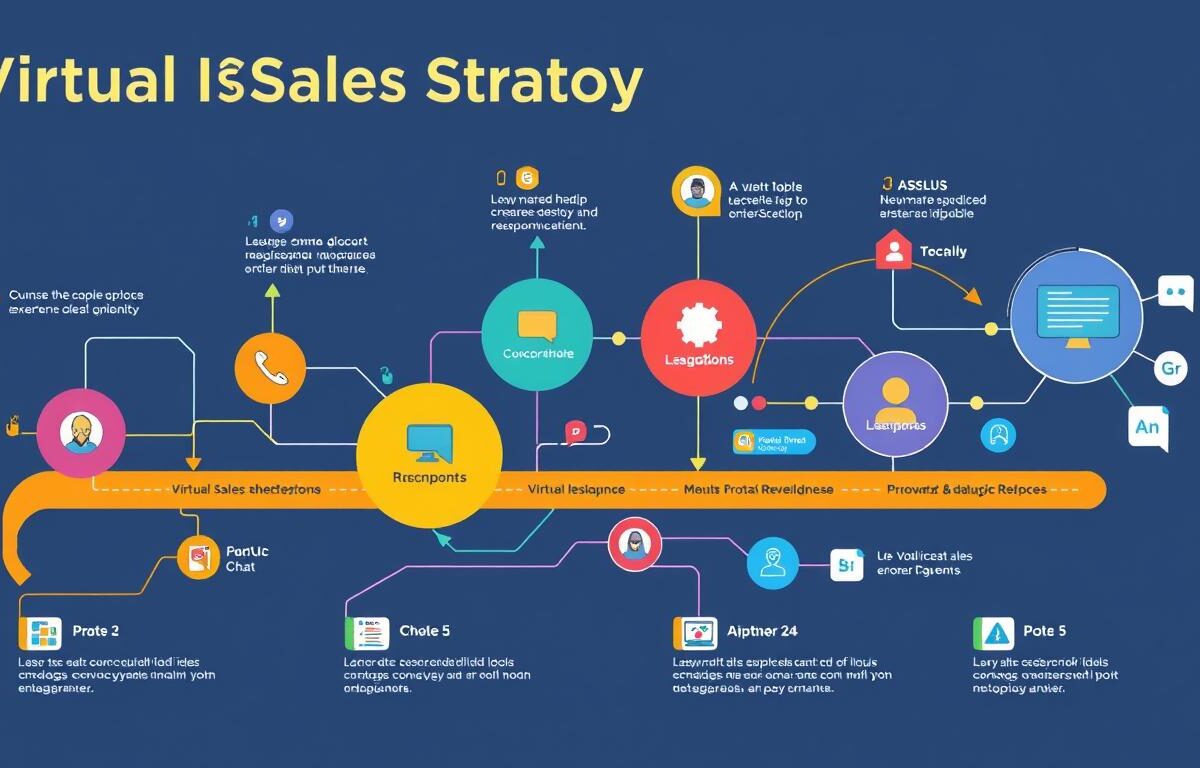In our digital-driven world, the need for virtual sales strategy development has spiked. It has shifted from a new idea to central in today’s market. Most sales now happen online, pushing companies towards online sales strategies. These strategies must be as impactful online as offline. Crafting virtual selling strategies means more than moving in-person methods online. It’s about creating new ways to excel in digital sales.
For virtual selling strategies to work, understanding and adapting to changed customer preferences is key. Today, buyers prefer digital self-service or remote interactions. Virtual sales teams must build solid digital relationships. They must offer personalized, detailed experiences that today’s customers look for.
Social selling is becoming crucial, as sales reps must be skilled on social media platforms. This skill helps them connect naturally with potential buyers. Using great visuals and clear audio boosts virtual calls’ effectiveness. Automation tools can also increase efficiency by taking care of follow-ups.
Data underlines virtual sales, helping to personalize outreach and create specific experiences for savvy buyers. It’s the blend of people, processes, and technology that creates strong virtual sales strategy development. This strategy meets buyers’ needs and drives companies toward ongoing achievement.
Key Takeaways
- Essentiality of embracing virtual sales strategies to meet the digital era’s demands.
- The importance of adapting traditional sales tactics for effective virtual selling strategies.
- Utilization of social media and high-quality visual content to engage potential clients.
- Deployment of automation tools for streamlined sales processes.
- Data-driven personalization as a cornerstone of modern online sales strategies.
- Embracing the virtual dynamic with tailored digital spaces for sales calls.
- The necessity of follow-up interactions to foster enduring client relationships.
Understanding Virtual Sales Strategies
The way we sell has changed a lot thanks to virtual sales strategies. These strategies use tech to improve how we reach and interact with people. This change has made us focus more on digital sales, virtual solutions, and techniques.
Definition and Importance
Virtual sales mean selling mostly through digital ways, like video calls and emails. It’s important because it matches how people like to buy today. Plus, it lets businesses reach more people without worrying about where they are. A big shift to virtual meetings has worked well, with 63% of sales leaders saying they’re just as good, if not better, than meeting in person.
Key Components of Virtual Sales
To do well in digital sales, you need a few key things. First, your team needs the best tools. Zoom, HubSpot, and LinkedIn Sales Navigator are examples. Also, lots of sales leaders are training their teams more for virtual sales. This helps them be better at talking to customers online. Your sales process should be clear to everyone, from start to finish.
Differences Between Virtual and Traditional Sales
Virtual and traditional sales are quite different. Traditional sales often involve face-to-face meetings. But virtual sales use online content and methods. About 40% of sales reps in the U.S. say they need better training for virtual sales. Building relationships is still key, but it’s done differently online.
| Aspect | Traditional Sales | Virtual Sales |
|---|---|---|
| Interaction Mode | In-person meetings, physical presence | Video calls, digital communications |
| Content Delivery | Physical documents, printed proposals | Digital presentations, emails |
| Scope of Reach | Geographically limited | Global reach, no geographical constraints |
| Training Needs | Product knowledge, interpersonal skills | Technical proficiency, virtual engagement techniques |
| Tools Used | Printed materials, face-to-face interaction enhancers | CRM systems, video conferencing software |
The table shows clear differences between the old and new sales ways. It highlights the need for virtual training and tools. This helps businesses and sellers stay on top in a digital world.
Assessing Your Current Sales Approach
To improve digital sales strategies, you need to look at your current methods. Start by closely analyzing your sales channels and figuring out how to make them better. This will help increase your sales performance online.
Analyzing Existing Sales Channels
It’s important to know how your sales channels are doing. Infosys found that many customers want more customized service. So, you should use data from past sales to see where you can better meet these needs. This might include tweaking your remote sales strategies to match what your customers want.
Identifying Areas for Improvement
After reviewing your sales channels, it’s easier to find where improvements are needed. Salesforce found that a good buying experience makes customers stay loyal. Adding something like live chat, which 82% of people like, can make a big difference. This not only boosts sales now but helps with your future digital plans.

By looking at your virtual sales approach, you can make smart changes. This can make a big difference in how people feel about buying from you. Consider these facts about what customers want and how it changes the digital sales game:
| Feature | Customer Demand | Industry Projection |
|---|---|---|
| Personalization | 31% demand increase | Customizable options prioritized |
| Live Chat Usage | Preferred by 75% | Industry worth nearly $1 trillion by 2023 |
| Video Chat Efficiency | 20% conversion rate | Comparable to 25-35% offline conversion |
Adding these features can do more than meet customer hopes. It builds a strong online sales approach that increases revenue and keeps customers coming back.
Setting Clear Objectives for Virtual Sales
In the fast-paced world of online sales, it’s crucial to set virtual sales objectives. With measurable online sales strategies, companies can form a practical plan. This plan boosts growth and revenue.
Making sure these goals fit with the company’s main aims is smart and necessary. It ensures all efforts move in the same direction. Let’s look into how to align virtual selling strategies well:
Establishing Measurable Goals
Setting quantifiable benchmarks is key. They show what success should look like. They help teams see how well they’re doing. These markers might be things like how many deals are closed or the size of deals, linked to steps that help the team succeed.
Aligning Objectives with Overall Business Strategy
For virtual sales to work best, they need to match your main business plans. This way, every effort and dollar spent on virtual sales helps reach bigger company goals. It raises ROI and fosters lasting growth.
- Use CRM tools to make selling smoother and manage leads better.
- Add visuals and interactive elements in online meetings to keep people interested and clear on topics.
- Have clear plans for sales discussions to stay on track and efficient.
By focusing on these specific yet flexible strategies, businesses can sync their daily sales efforts more closely with their overarching aims.
Target Audience Identification
Knowing who your target audience is, is key to great virtual selling strategies. It makes marketing more effective and aligns what you sell with what consumers want. This boosts your investments by meeting consumer needs closely.
Researching Buyer Personas
Researching buyer personas is a big part of virtual sales coaching. Creating detailed profiles helps sales teams connect better with different people. These profiles are based on who the buyers are, what they like, and how they behave.
- 34% of buyers expect sales reps to clearly explain solutions.
- Gartner points out the big pluses of using buyer personas in virtual sales strategies.
By analyzing data carefully, accurate buyer profiles are made. These help in responding well and engaging in a personal way. This is key for success in tough markets.
Segmenting Your Customer Base
Segmenting your customer base means you can send messages that really speak to them. This boosts customer interest and sales. Using online tools and data helps identify which customers are most likely to buy.
- Nearly 80% of B2B buyers figure out what they want before reaching out. This shows how important it is to talk about what matters to them.
- Companies that tailor their communication make 40% more money, says McKinsey.
By using virtual sales coaching, companies get better at segmenting their customer base. This means marketing will really hit the mark with different groups. Every chat or meeting becomes more meaningful.
Building a Virtual Sales Team
Today’s sales landscape has changed, needing strategies for virtual sales team development. This text offers insights on key roles and skills for success. It also discusses creating a collaborative remote sales environment. This aligns with the latest virtual sales techniques.
Roles and Skills Required
Creating a top virtual sales team starts with pinpointing important skills and roles. Attributes like self-motivation, online communication proficiency, strong web presence, and product knowledge are key. Also, a smooth onboarding process, ideally within 45 days according to SFI, shows quick skill integration is both possible and beneficial. Moreover, using CRM software like Salesforce, Zoho, and HubSpot is vital for keeping customer relations strong and sales processes efficient in a remote setup.
Fostering a Collaborative Remote Environment
Building a collaborative remote sales space is about more than just tools. It’s about making support and shared resources easily accessible. This helps share best practices and keeps the sales drive going. Tools like Slack, Zoom, and Kumospace are crucial for real-time team interaction and collaboration.
Having in-house teams means more control over management and training but higher costs. Sales Focus and similar firms offer an outsourcing option. This option allows for operation scaling and cost adjustments based on business needs. Each method has its benefits and fits different virtual sales strategy goals.
In summary, creating a successful virtual sales team involves careful skill selection, strategic technology use, and a supportive remote work environment. With the right people and tools, businesses can utilize virtual sales to grow and compete in the digital market.
Tools and Technologies for Virtual Sales
The rise of virtual sales tools has changed how we do digital sales. Having the right systems improves how we work and keeps us competitive in a digital world.
Essential Software Solutions
Important software for virtual event technology helps make sales smoother. It includes data analytics, digital sales rooms, and advanced communication tools. These help companies offer personalized and engaging experiences, which are key in remote selling.
- Data analytics platforms help us make smart, data-based choices. This optimizes our marketing and sales.
- Digital sales rooms allow for personal interactions, helping close deals quickly and well.
- Communication tools like videos and content sharing are vital for building trust from afar.
Leveraging CRM and Automation Tools
Using CRM and automation tools is crucial for a strong automation in digital sales strategy. CRM technology organizes customer information and makes sales tasks easier. Automation helps sales teams create very personalized customer experiences, a must in today’s digital age.
- CRM systems boost how we manage customer relationships. They help with better marketing, generating leads, and interacting with customers more personally.
- Automation tools like pricing calculators make routine tasks easier. They help with quotes and managing work flow efficiently.
Adding these tools to your virtual sales strategy boosts efficiency. It also makes customer interactions more engaging.
| Tool Category | Function | Benefits |
|---|---|---|
| CRM Systems | Customer Data Management | Enhances customer relationships, personalizes marketing, and optimizes lead generation. |
| Automation Tools | Task and Process Automation | Increases operational efficiency, reduces manual errors, and saves time. |
| Data Analytics Platforms | Insight Generation | Enables data-driven decision making to refine sales strategies and improve outcomes. |
| Digital Sales Rooms | Engagement and Closing | Facilitates dynamic, personalized sales experiences crucial for deal closure. |

Measuring Success in Virtual Sales Strategy
To keep up in today’s online market, knowing how to measure virtual sales success is crucial. By using clear virtual sales KPIs, companies can check their virtual sales work closely. These KPIs make ‘success’ something you can measure. They help companies improve and make smart decisions based on data.
Key Performance Indicators (KPIs)
Different KPIs like conversion rates and sales cycle length offer insights into virtual sales. A high conversion rate shows good customer engagement. A short sales cycle means buying is quick and easy. By watching these KPIs, companies can adjust to meet their big goals. They make sure resources are used right. This guides the virtual sales team towards steady growth.
Continuous Improvement Through Data Analysis
Predictive analytics help see future sales trends, leading to smarter strategies. Analyzing calls, emails, and virtual meetings, plus customer feedback, lets businesses quickly adjust to market shifts. Investing in training and AI tools helps keep improving. Today, over 75 percent of buyers prefer online talks, a view shared by sales teams. Success now depends on being flexible and using data well. It’s key for lasting success.
Measuring Success in Virtual Sales Strategy
What constitutes an effective virtual sales strategy?
An effective strategy involves clear digital sales processes. It also needs a skilled virtual team, proper tools, and regular training. It’s all about taking traditional sales online and tweaking tactics for the web.
How does virtual selling differ from traditional sales?
Virtual selling uses online tools like emails and digital presentations, unlike in-person meetings in traditional sales. It aims to build relationships and teach customers through digital means.
Why are virtual sales strategies important?
These strategies are vital for their global reach, convenience, and accessibility. They connect sales teams with customers worldwide. This ensures sales are both efficient and effective online.
What are the key components of a virtual sales strategy?
Key elements include setting a digital sales process and creating a capable virtual team. You’ll also need to choose tools like CRMs and video platforms. And don’t forget comprehensive training.
How are virtual sales techniques different from those in traditional sales?
Virtual sales need a shift toward valuing digital connections and building trust online. It requires great online communication and presentation skills.
How can existing sales channels be analyzed?
You can assess sales channels by their effectiveness and how customers respond. Use metrics and data to see their performance. This will show which channels might need a digital boost.
How do you identify areas for improvement in a sales approach?
Look at sales data and how customers engage to spot improvement areas. This might reveal needs for tech integration or better training.
What does establishing measurable goals for virtual sales involve?
Setting goals means creating specific targets like conversion rates. These goals must be achievable and link back to your main business aims.
How do you align virtual sales objectives with a company’s overall strategy?
Ensure your virtual sales efforts aid in business growth and meet revenue goals. This helps in using resources wisely and keeping strategies aligned.
What is the purpose of researching buyer personas for virtual sales?
Researching buyer personas lets salespeople grasp what the ideal customer wants and worries about. This helps tailor sales tactics to various customer types, increasing engagement and sales.
Why is segmenting your customer base important?
Segmenting makes your sales messages more personal and relevant. It makes your efforts more effective, boosting customer happiness and sales.
What roles and skills are required for a virtual sales team?
A virtual team needs time management, motivation, and skills in using online tools. They must have confidence online and know their product well.
How can a collaborative remote sales environment be fostered?
Foster collaboration through shared resources and constant communication. Provide round-the-clock support to keep your team working together and engaged.
What are some essential software solutions for virtual sales?
Key software includes CRMs for customer relations, pipeline tools, email marketing, social media tools, and quality video platforms. These come with features that help teams collaborate better.
How can CRM and automation tools be leveraged in virtual sales?
CRM and automation tools help manage customer data well and automate usual tasks. They offer analytics for smarter sales choices and respond better to customer actions.
What KPIs are important for a virtual sales strategy?
Key indicators include conversion rates, deal sizes, cycle times, cost to acquire customers, and satisfaction scores. They track progress and success.
Why is continuous improvement through data analysis vital?
Improvement through data lets you refine sales strategies over time. It offers strategic insights and fosters a culture ready to adapt to virtual selling changes.



